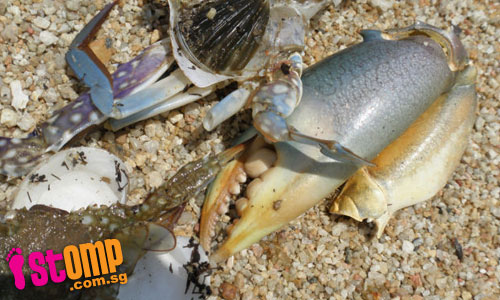
STOMPer mariner saw some dead crabs washed ashore on a beach at Sembawang Road and wondered whether the polluted waters had caused them to die.
The STOMPer says:
"These pictures were taken at the end of Sembawang Road near the Kampung Wak Hassan.
"At low tide I noticed that many dead crabs were washed ashore.
"Was this due to the polluted waters of the Johor Straits?
"The beach was polluted and there were coconuts, shoes, tree trunks and plastic bottles strewn all over the place.
"I hope this beach can be cleaned up."



It's impossible to draw any conclusions based on a few dead crabs; they may not even be dead crabs in the first place, but moults, discarded after the crabs have shed their exoskeletons. Here's a link that helps distinguish between moults and genuine carcasses of crustaceans.
The crabs in these images appear to be mostly flower crabs (Portunus pelagicus), although the pincer in the last photo is likely to be that of a mud crab (Scylla spp.), although I'm not confident about narrowing it down further to a particular species.
It is misleading to imply that the crabs may have been killed by pollution, for several reasons.
For one thing, pollution (in the sense of toxic chemicals or oil spills) tends to be quite indiscriminate where it comes to selecting victims.
The person who submitted this to STOMP only mentions dead crabs being found, but did not say anything as to whether other forms of marine life appear to have been affected or not. If there was a serious case of pollution, one would expect a greater diversity of casualties. For example, the mass death at Chek Jawa 3 years ago affected a wide range of species, including various echinoderms, molluscs, sponges and cnidarians. Even the more recent fish die-off that affected the seas off Pasir Ris involved many different species of fishes.
In comparison, finding a handful of dead flower crabs, a pincer of a mud crab, and an empty shell of pearl conch (Laevistrombus turturella) seems quite underwhelming, even pathetic. It's difficult to imply that pollution is wiping out the marine life when that's all the evidence you have.
There are so many other possibilities that were not considered. Some or all of these crabs could have been empty moults in the first place, which pretty much negates the whole idea of crabs dying en masse. Even if these crabs are genuinely dead, they could have been discarded by anglers or fishermen. They could have died from natural causes, and the bodies were washed up on the beach. If the crabs were larger, I would have raised the possibility that the crabs may have been casualties of animal liberation.
True, pollution is a serious threat to the health of our marine ecosystems, and we should do more to help combat this problem, but finding a few dead crabs and suggesting that they were killed by pollution is stretching things a little.